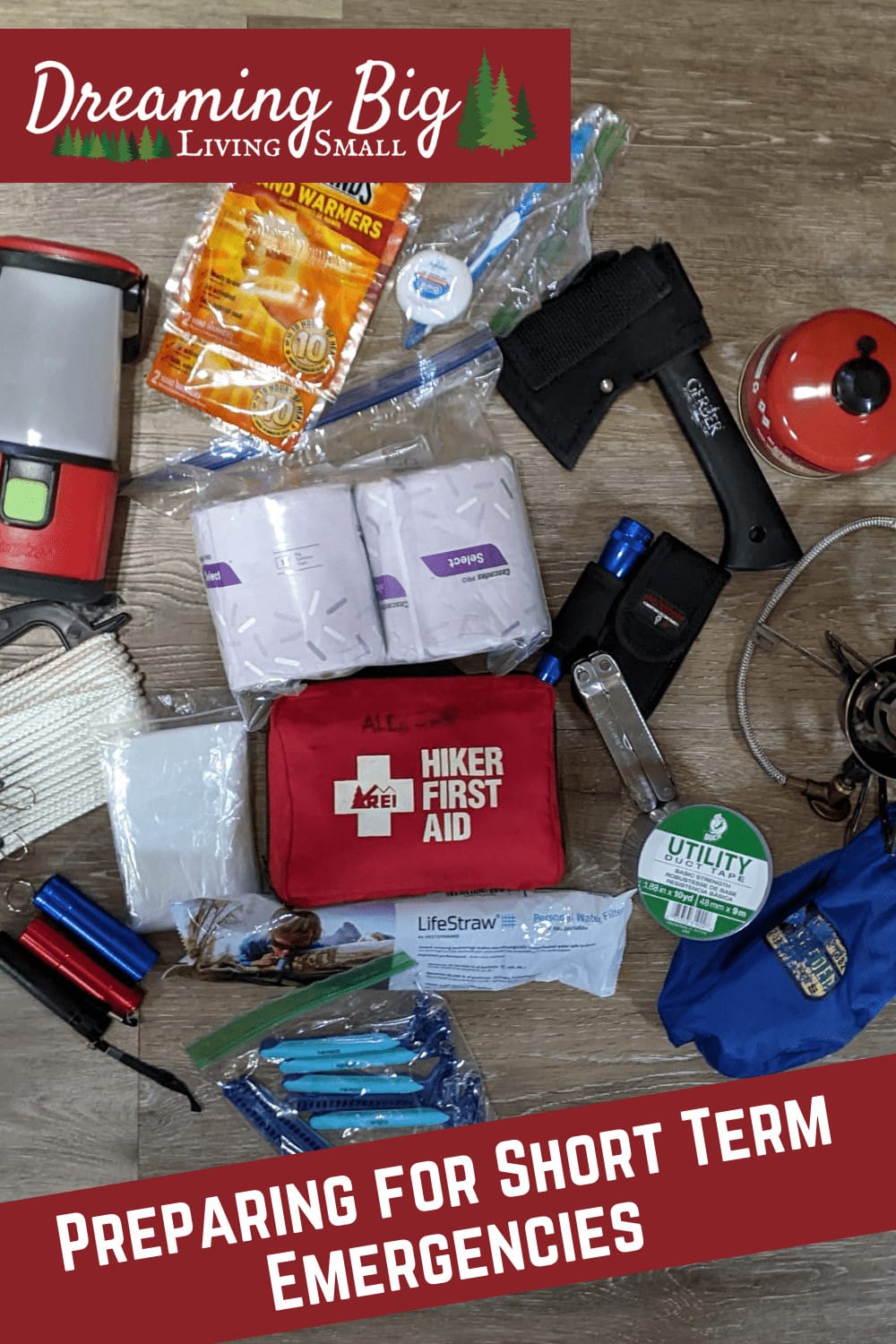Years ago, our family used to live at the beach. And anyone that has lived at the beach knows the risks of large storms and tsunamis. Over the years that we lived on the Washington coast, we were lucky enough to never have a big tsunami that set off the alarms. But the regular tests kept the risk ever-present in your mind.
You needed to be prepared to leave the area at a moment’s notice. Having 72-hour kits or bug-out bags ready to go was important. Now that we don’t live on the coast, I have wondered if I even need to have bags anymore. I mean, when we lived on the coast, we were terrible about having them ready.
Often the clothes would end up too small for the kids and the food was out of date if we even had them at all. But the recent unrest, heavy winter storms, and even wildfires that have affected the area we are living in now have kept me thinking that they are just as important no matter where you live.
What is a 72-hour kit?
A 72-hour kit or bug-out bag as they are commonly referred to is normally a bag, camping backpack, or tote that contains everything you would need to survive for up to 3 days. This can vary a lot per person, and even within your family.
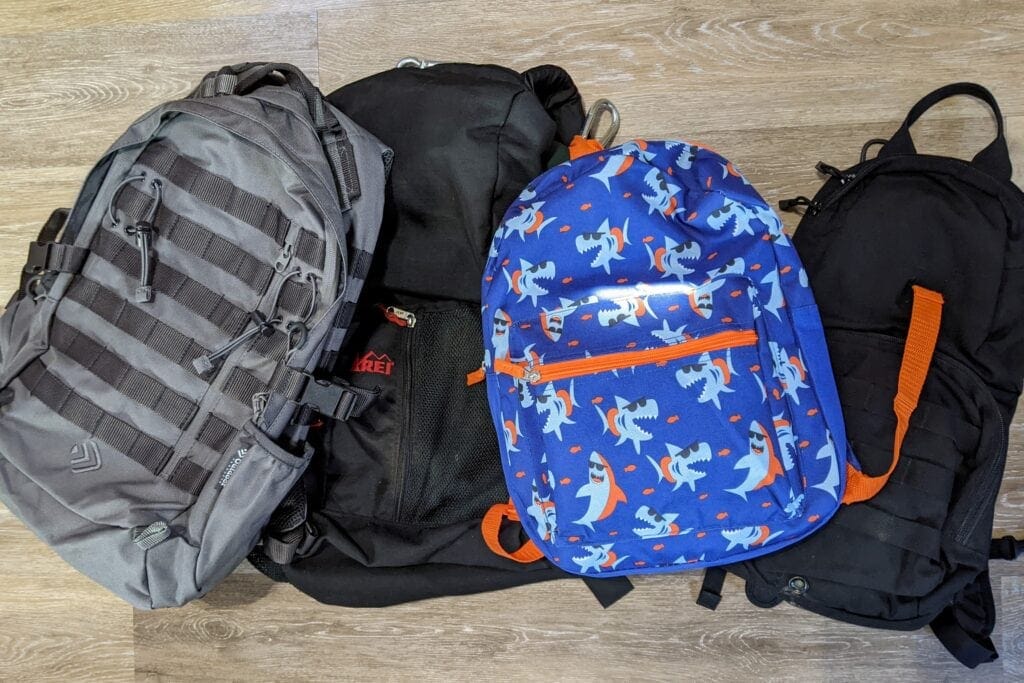
For example, as an adult, I would be carrying a lot more gear such as a backpacking stove than my 4-year-old son. But each member of your family should ideally have a kit of their own. In the unhappy event of a child being separated from you, their kit can help to comfort them, and provide them with some basic life essentials.
A 72-hour kit will normally have food and clothing, in addition to the gear for survival. It should be compact enough to be carried if needed. You never know if the emergency you are facing will cut you off from vehicle access and require you to leave on foot.
What else should be in a kit?
Since a bug-out bag can vary so much from person to person, I will go over the basics inside this article. At the bottom of this article, you can find a downloadable packing list that I put together that contains the full list of items, including optional and recommended items I don’t discuss in this article. Remember that just because I put something on the list, does not mean it is important to you. You should always make sure you have the supplies you will use the most, with as little extra gear as possible.
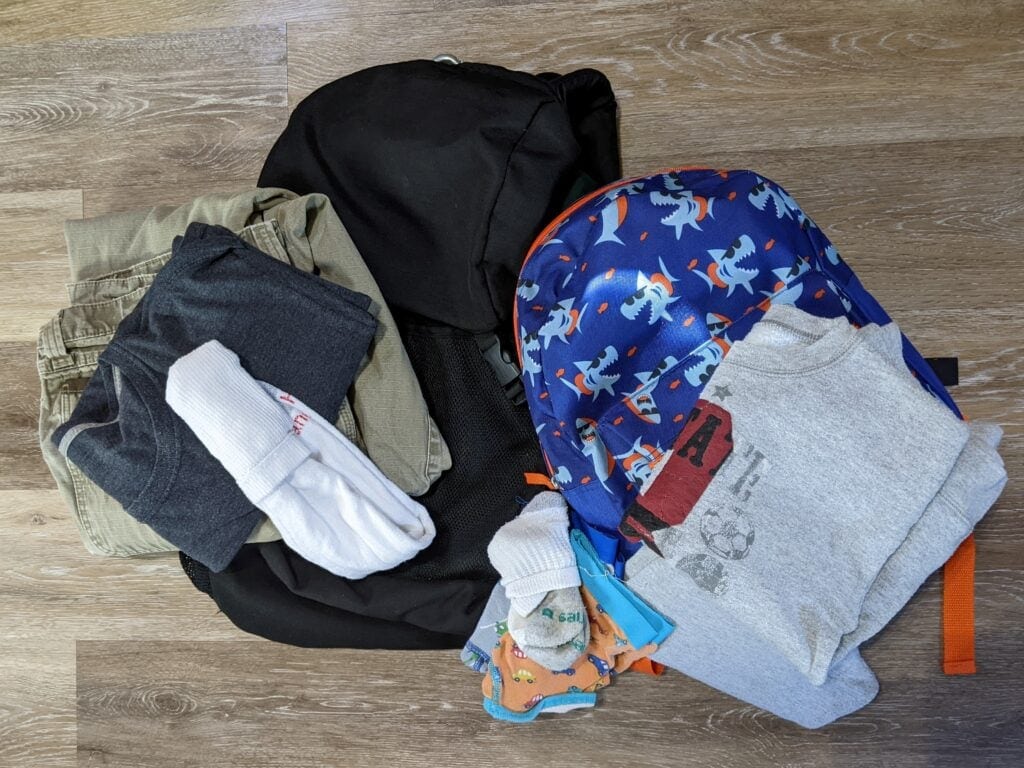
Clothing
Each bag should have a change of clothes for up to three days if possible. This can be hard to fit depending on the size of the bag, and weight should be a factor.
Children will have a harder time carrying their bag if it gets heavy, and very young children might not be able to carry them at all. Adding in lots of clothing can weigh the bag down, and possibly take up valuable space that should be used for food and other life essentials.
Remember – We live in the real world, not the Harry Potter world where the bag goes on forever with everything inside…
If you need to, cut the clothing down to a single day, or one set of outer clothes and three sets of under clothing. Consider the seasons and pack clothes to keep you warm or cool as needed.
Don’t forget things like diapers for little ones that may still need them. With our new one on the way, this is something we are adding to our bags. Even if you use cloth diapers normally, pack some disposable ones. You don’t know if you will be able to wash, so being prepared is always good.
Food
Your bag should contain enough food for at least two meals a day for three days. Freeze-dried meals tend to work great here because they are smaller and lighter than normal foods. MREs (Meals Ready to Eat) are also commonly used because of the portability and the fact that they contain everything you need. Some MREs even contain little bottles of tabasco sauce and candy. There is a reason why the military uses them so much.
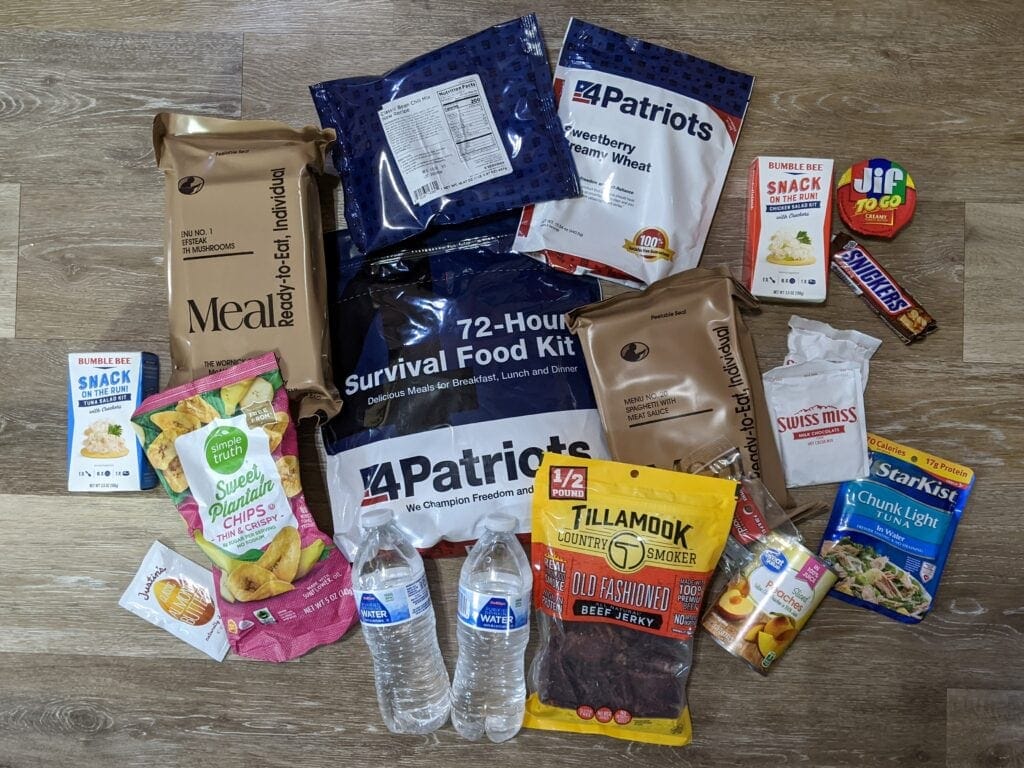
I would also consider packing energy bars or granola bars to give you a between-meal boost. Fruit leather is another good way to supply your body with essential fruits and vegetables while being very shelf-stable.
A food item often not considered is comfort food. Pack a candy, or treat, especially in children’s bags. Think of things like gummy bears, or any other favorite. Not only could a candy help calm a stressed-out child, but it can calm your nerves as well.
Essentials
As we live in the Pacific North Wet (yes, it’s very wet), having a poncho is essential in our bags. Other essentials for adults and older children may include a pocketknife, rope, or a tent. A small backpacking stove will come in handy should you choose to go the route of freeze-dried foods.
Everyone’s bag should have items such as a flashlight and toilet paper. While our whole family has water bottles that they use daily, we choose to keep a couple of plastic water bottles in each bag, along with a LifeStraw to filter water should the need arise.
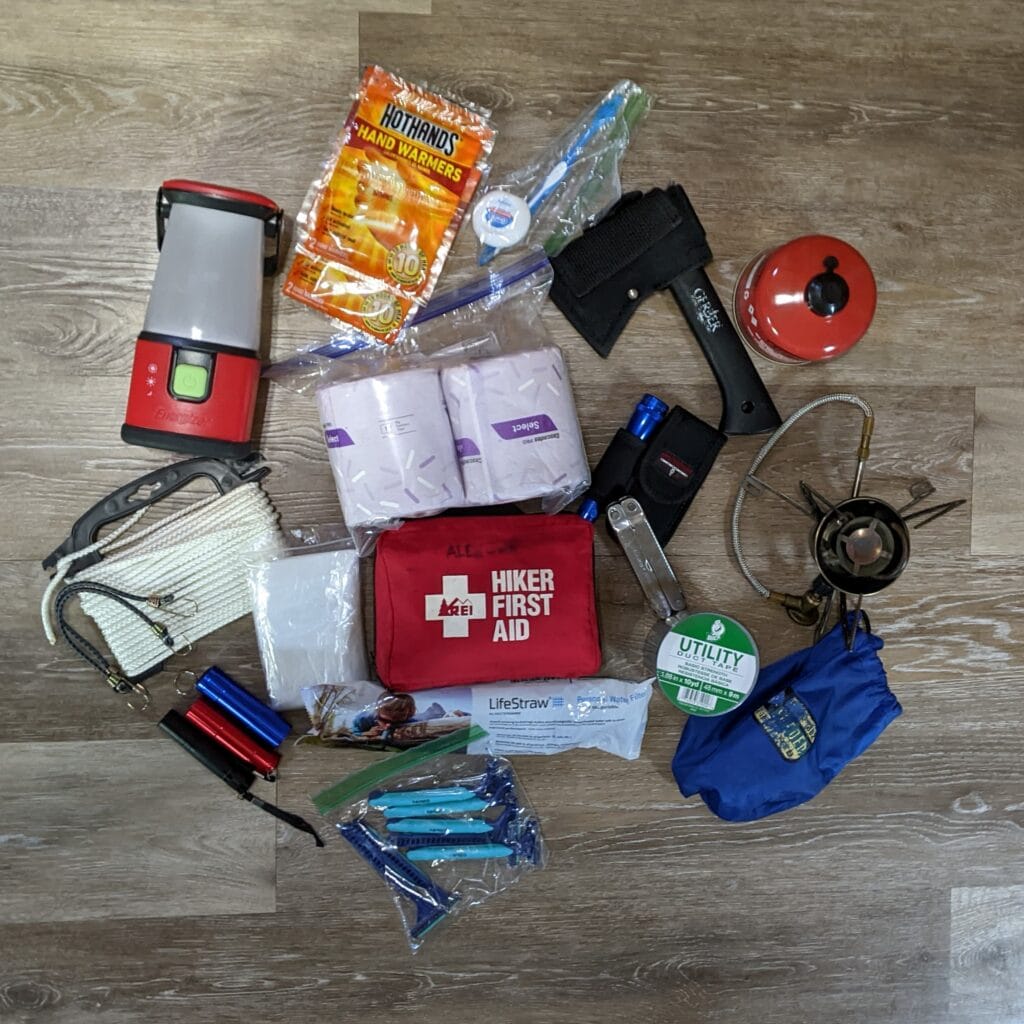
Remember, you want to try and overlap gear as much as possible and reasonably able to be carried. You never know when someone might be separated from your family and need their gear.
Other basics can include a small sleeping bag, first aid kit, flint & steel, medicines, hygiene kit, a compass, and paper & pen. Extra band-aids are also something I would recommend, especially if you have little kids.
Extras
You can always pack extras if you have room and weight availability. Even if you may not need the extra items, you might run across someone that can use it. Everyone tends to think that it’s everyone for themselves, but when the crap truly hits the fan, we all are going to need each other. Strengthen those around you and work together. You never know when the skills of others can help your own to survive.
How often should I rotate and check my bags?
A bug-out bag is only as useful as the gear that it contains. If it is full of clothes that are too small and expired food, it won’t help you get very far. But there is a balance to how often you should be checking over your bags as well. Being prepared is NOT something you want to stress over in your life, but rather make an enjoyable part of your life.
I recommend going over everything in your bag at least every six months. Many people will do this spring and fall so they can rotate the clothing in the bag to stuff that is proper for the upcoming seasons.
When you are rotating your bags, you should pull everything out. Don’t just check on the clothing and food dates. Make sure that you remove everything from the kit and check each thing. Batteries should be checked for corrosion; lanterns & flashlights should be tested.
Even unused items should be gone over. Toilet paper tends to degrade over time and should be rotated. Pocket knives should be checked for damage and sharpened if needed.
Certain types of sleeping bags do not do well stored in their stuff sacks. Over time they lose the insulating properties being compressed. If this is the case with your sleeping bags, you should keep them hanging outside of your kit.
During your rotation times, you can practice grabbing your gear from its locations and see how long it takes you to get ready and out the door. Keep this time in mind and always see what you can improve.
If you want to make it a fun activity for your kids, have them set up the tent. This will not only ensure every part is there, but it will also keep everyone knowledgeable on how to set the tent up.
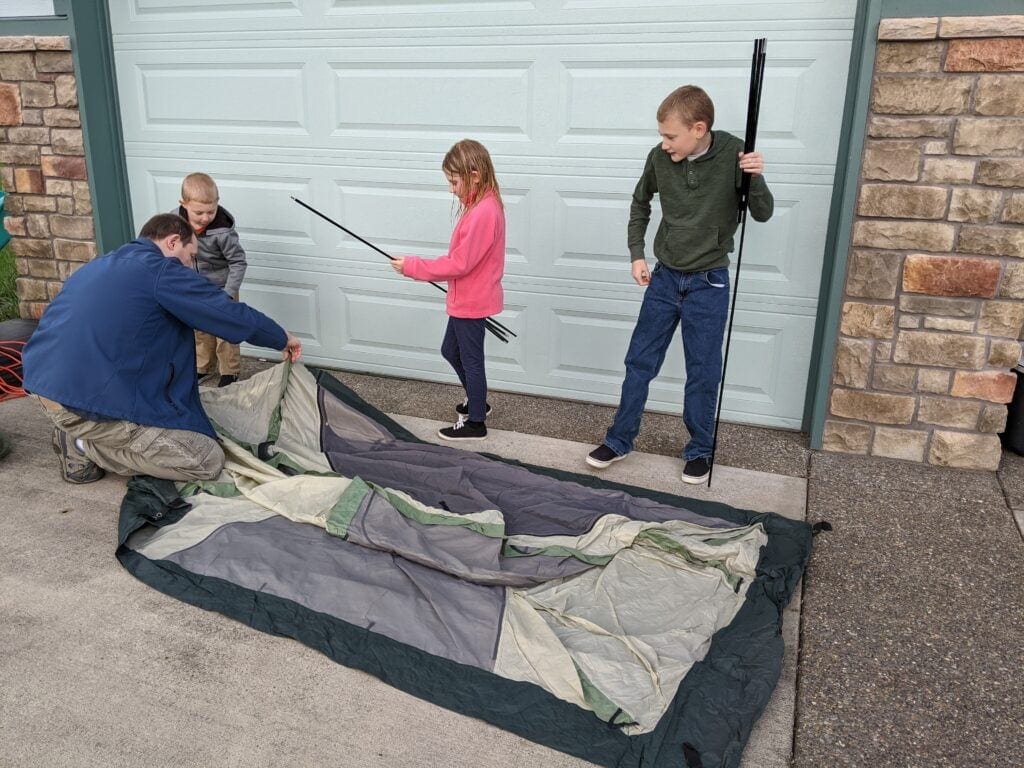
We keep our bags hanging on hooks in the shop. Many people keep them in their garage. No matter where you choose to store them, make sure you keep a clear space around them, so they are easy to get to. Ensure you keep everything in one area, so you are less likely to forget something in an emergency.
Other places for bug-out bags
A 72-hour kit is not just for yourself and should not just be at home. I recommend you keep a small kit in your car if possible. Generally, a vehicle kit will be stored in a small tote and won’t contain near as much as a home kit due to daily space concerns. But you never know when an emergency will occur. Having something with you, no matter how small can help you in every situation.
Some people may not have space for a kit, but instead, choose to keep a kit in another trusted location such as a neighbor’s house. Or you might even keep two kits.
I recently read in a Facebook group I am part of how someone was concerned that when they stay with family, the family is unprepared for just about anything. The group came up with a suggestion of the person keeping a second kit at the family member’s house since they are over so often.
This had the secondary effect of helping the family members (unknowingly) should something happen as the kit was available for anyone to use at any time.
Think about the places you are regularly and plan how you can be prepared for an emergency anywhere you are.
Conclusion
Emergencies happen every day. People get displaced from homes. Extreme weather hits.
If you take a little time today to prepare for tomorrow, you will be able to overcome the unexpected. Hopefully, in this article, I was able to give you some ideas and help you to prepare your family for life’s unexpected emergencies.
Remember, planning and preparing a 72-hour kit is nothing to stress over. It does not have to be done in a single day and should be affordable. Don’t go out and purchase everything and mess up your budget. Gather the gear as you can and eventually you will have what you need.
If needed, start with things like food and a change of clothes. Work your way up to a full kit. You will still be better off in an emergency with some food and a set of dry clothes than nothing at all.
We are still adding and changing our family bug-out bags. It’s not a race to the finish, but a journey to be lived.
Get Your Free 72-hour Bag Packing List
Subscribe to get your free 72-hour Bag Packing List, which contains everything you should have including lots of recommended items not discussed in the article. Unsubscribe with one click at any time.
We hate SPAM and promise to keep your email address safe. Here’s our privacy policy.
